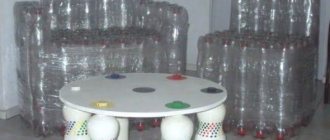greenhouse made from plastic bottles with your own hands
You don’t have to tell me what a useful thing it is, reusing plastic containers. But in practical terms, these are functional and cheap projects; anyone can make a greenhouse from plastic bottles with their own hands ; neither experience nor special tools are needed. Below you will learn the advantages of using such greenhouses, and five specific examples with step-by-step photos. But besides this, plastic bottles are an excellent material for making a micro greenhouse for seedlings or just a small home greenhouse in a bottle . The article presents 12 such examples, including interesting projects for a self-watering mini greenhouse and a simple hydroponic system made from plastic bottles .
What you need to know about greenhouses
Purpose
Like a greenhouse, a greenhouse is used to create a favorable microclimate when preparing seedlings or when fully growing tomatoes, cucumbers, cabbage and other plants.
In a broad sense, both structures are perceived as the same thing, although in fact a greenhouse is a small and unheated structure. A greenhouse is a larger building with a heating and ventilation system, which allows for the cultivation of many crops at any time of the year.
Design
The structure of greenhouses is quite simple. A frame is assembled from pipes, metal or wood, which is covered with film, polycarbonate, glass, acrylic and other light-penetrating materials. If the weight of the structure is very large, it is additionally installed on the foundation.
For ventilation, removable panels or opening transoms are provided. Heating is carried out using water heating with radiators, infrared heaters or hot air from heat sources outside the greenhouse.
Installation
Since sunlight is vital for plants, the greenhouse should be built on the south side. It is advisable to place it on a slope and closer to other buildings in order to protect it from the wind and have access to utilities. It is better to stay away from high fences and trees: they provide shade, and falling leaves reduce light transmission.
Tomato and cucumber greenhouses
To create a favorable climate for tomatoes and cucumbers, experts suggest using transparent and dark bottles , alternating them with each other.
In this way, balanced sunlight is obtained. Usually these are large greenhouses, at least 18 square meters. To set up such a “place” of residence for vegetables, almost 2 thousand bottles will be required. Of course, setting up a greenhouse will require a lot of effort and time, but the end result is worth it.
You need to make spikes in the tomato “apartment”. The plastic blanks themselves are attached to the slats using a furniture stapler . As for the cucumber greenhouse, first a baguette is nailed to the rail, and then the blanks are attached to it.
Do-it-yourself greenhouses using plastic bottles, durable and warm structures . Spring frosts will not harm the seedlings, so they can be safely left in the greenhouse without covering them with any other materials.
In those regions where the winter has little snow and plastic bottles can be used for the roof. The fact is that a large snow load can lead to tearing of the seams. In snowy areas, as a rule, the upper part of greenhouses is covered with reinforced film or polycarbonate.
How to make a greenhouse with your own hands from agrofibre and reinforcement
youtube.com
- Assembly complexity: low.
- Foundation: not required.
- Cost: low.
- Variations: the frame can be replaced with plastic pipes, and the covering material with film.
The simplest design option, which is ideal for a small greenhouse. A frame made of reinforcement is installed directly on the bed, and agrofibre or, as it is also called, spunbond, is stretched over it. This material protects from the sun while retaining heat and moisture.
1. The dimensions of such a greenhouse are chosen arbitrarily, depending on the footage of available materials. For example, it is convenient to cut six-meter reinforcement in half. With such a length of arcs, the width of the greenhouse is about 80 cm. The arcs themselves should be installed in increments of 1.2–1.5 m.
teplica-exp.ru
2. Arcs are bent from reinforcement with a diameter of 8 mm. Next, drip irrigation tubes or an old hose are put on them, leaving 10–20 cm at each end so that it is convenient to insert the structure into the ground.
ebayimg.com
3. After marking the installation locations for the arcs, scraps of steel pipes or drilled wooden pegs 20–30 cm long are driven into the ground, and the reinforcement is inserted into them.
stopdacha.ru
4. Spunbond can be stitched on a sewing machine, forming pocket folds that fit directly onto the arches. Another option is to install plastic pipe guides on the sides of the beds and attach agrofibre to them using purchased clips or cut pieces of pipes. The covering material can eventually be easily lifted by simply removing them.
stblizko.ru
5. If desired, you can attach the arcs not to pipes driven into the ground, but to metal guides rigidly fixed at the edges of the base. This design will allow you to fold the greenhouse like an accordion, simply by moving the arcs.
must.kz
6. The free ends of the spunbond at the ends must be collected, tied in a knot and secured with a peg, earth or other means.
samara.kinplast.ru
Here are step-by-step video instructions.
Plastic bottles as a material: advantages and disadvantages
Advantages:
- durability: it is clear that plastic bottles do not wear out, fungus does not grow on them, and if a defect occurs, it is enough to just replace a bottle or two;
- availability: a greenhouse made from plastic bottles is cheaper than all other possible materials;
- ease and simplicity of making a greenhouse from bottles: you don’t need to be a super ace in construction for this;
- the ability to make any greenhouse design from bottles: a house, a lean-to, an arched structure, and so on;
- ease of installing a greenhouse anywhere in the garden and moving it to this place without disassembling its components;
- versatility: a bottle greenhouse is suitable for a variety of tasks, from growing seedlings to maintaining heat-loving plants in the cold season;
- temperature stability (bottles can withstand significant temperature changes from -50 to +130°C and do not heat up);
- environmental friendliness: the bottle material is chemically neutral and harmless to humans, earth and plants;
- beauty: you can choose the color of the bottles so that the greenhouse becomes a real work of art.
There are only two disadvantages:
- it is quite difficult to collect the required number (minimum 300–400) bottles for a greenhouse;
- It’s quite difficult to find the time to painstakingly assemble a greenhouse from bottles.
How to make a greenhouse with your own hands from masonry mesh and film
dachadecor.com
- Assembly complexity: low.
- Foundation: not required.
- Cost: low.
- Variations: instead of film, you can use agrofibre, and make the door on a wooden frame.
A budget option for a greenhouse made from masonry mesh and regular film, which is quickly assembled and has a number of advantages. The design does not require a foundation; due to its elasticity, it is resistant to wind loads, and is also convenient for tying up plants from the inside. At the same time, by folding the mesh, you can get different sizes depending on your needs.
- Wooden beams, steel angles, pipes or channels are used as load-bearing posts. They are hammered at a distance of 1.2–1.4 m.
- The greenhouse arch is formed from two pieces of mesh laid overlapping. From below it is attached with wire to the posts, and from above it is fastened together with the same wire or plastic ties.
- To strengthen the structure, T-shaped supports made of wooden beams 50 × 50 mm are installed in the middle of the passage. If desired, they can also be driven into the ground.
- A film is put on a dome assembled from a mesh, which is held in place by strings of twine or rope stretched over it.
- The side walls are also made of film, which is folded up and attached to the dome with tape. In several places at the top and bottom, small windows are cut for ventilation of the greenhouse.
- The door is made on a wooden frame or made from the same film, which is cut and attached to the side wall with magnets in the manner of door mosquito nets.
Manufacturing of metal products to order
Projects of any complexity
5 year warranty on all products
More than 300 satisfied clients
Reliable metal structure (greenhouse) made from a steel angle
There are a huge number of options for constructing a greenhouse, and one of the most economical and reliable is a greenhouse made from a steel equal-angle angle. At the same time, you can focus on other options: for example, take not an equal-flanged corner, but a different-flanged one, not hot-rolled, but bent, not steel, but aluminum - it all depends only on the availability of materials and the imagination of the builder.
Strengths
If you choose the right steel corner of the right size, then the greenhouse made from it will be durable, strong, but at the same time light and inexpensive. In winter, it can withstand heavy snow loads.
Greenhouses made from metal corners are easy to assemble even by non-professionals and just as easy to dismantle and move (if there is no foundation under them).
To make the angle steel frame last even longer, you need to treat it with an anti-corrosion compound. In this case, it would be preferable not just anti-corrosion impregnation, but paint containing zinc or polymer, which will protect the structure from bad weather.
Instructions
Such a metal structure does not necessarily require a foundation, however, if desired, it can be equipped. The greenhouse can be covered with film, glass or polycarbonate.
To assemble the frame, you must first make a drawing. There are many design options, and one of the most optimal is the shape of a house with a gable roof so that precipitation and snow roll off it.
For such a greenhouse, you need to cut blanks from the corner - 4 equal to the length and 4 equal to the width. Then you need to make lower and upper frames out of them, connecting the corners with ends cut at an angle of 45 degrees and connected at right angles.
Then blanks for the roof are cut out and welded in the form of two triangles and a number of rectangles. To strengthen the roof, which will take on the pressure of snow and wind, it is advisable to weld a jumper from a steel strip somewhere at half the height of the triangle.
Lastly, vertical racks are prepared according to the number of rectangles. Rectangles and triangles are attached to the top frame, and racks to the bottom. Then both “halves” are connected. Welding will be the most reliable fastening for such a greenhouse.
To finish, weld the ridge element onto the tops of the rectangles from the steel corner, reinforce all structural components by welding, strengthening them additionally if necessary. The frame is ready. You additionally need to make a door and, if necessary, a window onto it, and then stretch the covering material. We follow all the news in the field of metal structures and will keep you informed.
How to make a greenhouse with your own hands from stretch film with a wooden frame
stroydachusam.ru
- Assembly difficulty: average.
- Foundation: not required.
- Cost: low.
Another way to quickly build a greenhouse. A wooden beam is used as a frame, and stretch packaging film is used as a covering material. With a large number of layers, it transmits light a little worse than ordinary PVC film, but on hot days this is even a plus.
- The film is sold in rolls, so the dimensions of the greenhouse are selected according to the cutting of the timber and taking into account your wishes.
- For the base, steel corners 40 × 40 mm are used, in which holes for attaching the frame posts are pre-drilled. They can also be treated with bitumen or painted to extend their service life.
- The corners are driven into the ground, and pieces of timber are screwed to them with self-tapping screws. A lower frame, in turn, is attached to the beam, on which the side walls and roof are assembled. All corners are reinforced with additional inclined sections of timber.
- The door is assembled on a wooden frame in one of the side walls and installed on hinges.
- Film wrapping is done in parts, in several layers and overlapping. First, the gables are installed, then the roof slopes, and only then the walls. You need to start wrapping them from the bottom so that running rainwater does not get inside the greenhouse.
- After wrapping with glazing bead or river, the door and its outer contour of the door are trimmed, and then the film around the frame is cut through. In the same way you can make a window in the opposite wall.
Greenhouse lighting
A year-round greenhouse requires additional lighting equipment, because... natural light will not be enough.
Use:
- Classic lamps - at the junction of the roof and walls or high on the side.
- LED lamps are the best option for large areas (saving energy). They are durable and safe to use. Mounted at the highest point of the ceiling - maximum area coverage.
Automation of switching on - a block with a timer. It creates comfort by simulating daylight - it gives commands to the lamps to start and stop working. This greenhouse option is suitable for professionals for growing vegetables, flowers, and exotic plants all year round, including in winter.
For a seasonal building, additional lighting is not needed.
How to make a greenhouse with your own hands from old window frames
teplica-piter.ru
- Assembly difficulty: average.
- Foundation: desirable.
- Cost: minimal.
- Variations: you can combine frames with film to make a roof, side walls or doors.
The main advantage of this design is its low cost. Old window frames can be found, if not free, then for a nominal price. In addition, glass transmits light much better than film and polycarbonate. The windows already have vents for ventilation, and if you select a balcony block, you will also have a ready-made door.
- The size of the greenhouse depends on the size of the frames and the interior space you need. Aim for a width of about 2.5 m to give a passage of about 60 cm and two beds of 80–90 cm.
- Windows and glass have considerable weight, so it is advisable to install them on a solid base. This can be a shallow strip foundation, a massive wooden beam or a metal profile.
- A wooden frame or pillars are installed on the foundation at the corners, and frames are attached to them and to each other. The gaps between each block are covered with putty and clogged with strips of laminate backing or a thin wooden strip.
- A door is made in the front wall. Its role can be played by one of the windows, a balcony door or a wooden frame covered with film. Ventilation is provided through window vents.
- To reduce weight, it is better to make the roof from wooden beams and film. You can use the same window frames, but in this case you will have to reinforce the structure with supports in the middle of the passage so that it can withstand a lot of weight.
Preparation for construction in general
First of all, we need to understand what size greenhouse we need. Considering the complexity of collecting components, there is no need to make it too large.
Let our structure be on a wooden base, in the form of the most primitive small house. We assume the dimensions of the base are 2x3 meters, the height of the greenhouse walls is 2 meters, the height of the ridge is 1 meter.
We draw the drawing by hand, set the dimensions and estimate how much timber, slats, screws and corners we need to purchase.
Drawing of a greenhouse, sketched in haste
For the frame we will need a thin pine beam 40x40x6000 mm.
Edged pine block 40x40x6000 mm - the basis of the structure
To connect it into the structure there are metal corners.
Corners are needed to strengthen joints
To connect bottles into pipes, use thin wooden slats 20x20x3000 mm.
Pine slats 20x20x3000 mm
To fix the parallelism of the walls, use three rolls of thick fishing line.
Fishing line is needed to fix the walls
To cover the roof - a piece of hose film.
Tubular film is needed not in a roll, but in footage
When we calculate the required amount of materials, we will be pleasantly surprised at how cheap our project is. It’s funny, but the most expensive thing is not even the timber, but the strip needed to be threaded into the bottle “pipes” to create stiffening ribs. in fact, you can do without slats, or thread a wire or wire into the “pipes”. And the bottles will not cost anything at all - except for the labor of collecting enough of them.
Bottle preparation
- You need to collect about four hundred two-liter bottles. White plastic (water bottles) transmits ultraviolet light better. And to decorate the structure, you can choose a number of bottles of a different color: blue (sparkling water), green (drink bottles) and brown (beer bottles). In fact, bottles come in all the colors of the rainbow. But only these four are produced en masse (in order to collect the required quantity).
The four most common bottle colorsWith some effort, you can create beautiful ornamented greenhouse walls from them.
A greenhouse with a smile, creativity is immediately visible - Bottles must be removed from stickers in advance. It is better to use bottles with regular paper stickers that can simply be soaked.
Required Tools
- Bayonet shovel
- Shovel
- Power saw (hacksaw).
- Hydraulic level.
- Carpenter's corner.
- Drill (with a set of drills).
- Hammer.
- Awl.
- Shoe knife.
- Roulette.
- Screwdriver.
- Installation stapler.
Calculation of required materials - table
| Position | Name | Specification | Quantity | Unit price | Price | Notes |
| 1 | Edged pine beam | 40x40x6000 mm | 6 items | 95 RUR/piece | 570 rubles | |
| 2 | Equal-sided galvanized mounting bracket | 40x40x60x2.0mm | 25 pieces | 35 rub/piece | 875 rubles | |
| 3 | Planed pine slats | 20x20x3000 mm | 50 pieces | 35 rub/piece | 1750 rubles | |
| 4 | PET bottles (plastic) | capacity 2 liters | 400 pieces | |||
| 5 | Fishing line calibrated 1.00 mm | 1.00 mm x50 m | 3 skeins | 90 rubles | 270 rubles | |
| 6 | Polyethylene film 80 microns | width 3m / sleeve 1.5m | 4 meters | 20 rub/m | 80 rubles | |
| 7 | Antiseptic impregnation (and optional paint) | As needed, but small quantities | ||||
| 8 | Adhesive tape transparent wide technical | 75 mm x 50 m | 3 skeins | 49 RUR/skein | 147 rubles | |
| 9 | Self-tapping screws | About 2 kg | As needed | |||
| Total | 4412 rubles (excluding the cost of screws, impregnation and paint) | |||||
How to make a greenhouse with your own hands from film and polypropylene pipes
maja-dacha.ru
- Assembly difficulty: average.
- Foundation: not required.
- Cost: low.
- Variations: the film can be replaced with agrofibre or polycarbonate
A greenhouse made of polypropylene pipes attracts with its simplicity, reliability and low price. The materials are sold at any hardware store, and assembly does not require any special skills or tools. You can even do without a soldering iron if you connect the pipes not with fittings, but with through bolts.
- As always, sizes are selected based on needs and available materials. Polypropylene pipe is usually sold in 4 m sections, and it is easy to cut and splice using couplings.
- The first step is to calculate the length of the pipe and the number of fittings required. It’s better to take it with a reserve so that you don’t have to run to the store later.
- The main parts are soldered from pipes, tees and crosspieces - arches with crossbars and longitudinal inserts.
- Next, the greenhouse is assembled from the prepared parts. If a soldering iron is not at hand, you can use bolts with nuts and washers to connect, which are inserted into pipes drilled through.
- The film is secured to the edges of the frame using purchased pipe clamps or homemade clips made from slightly larger diameter pipes cut along sections.
Sliding greenhouse design
From aluminum and PVC pipes, which can be purchased at a plumbing store, you can make a retractable roof for a greenhouse. In addition to pipes and boards for the box, you will need to buy plastic plumbing tees.
Two metal guide pipes are installed along the wooden box. Plastic tees are put on the pipes; the diameter of the pipe should be slightly smaller than the diameter of the tee so that the parts slide easily. Long, flexible PVC pipes are inserted into the tees and bent in an arc. The film is stretched over the structure and secured with a PVC hoop, as described above.
The retractable roof allows you to cover the plants in early spring and leave them to grow in the open air in the summer; there is no need to replant them.
Making a greenhouse with your own hands is not at all difficult. To get inspired by ideas, look on the Internet for photos of DIY greenhouses. To work, you will need improvised materials that you can find at home or very inexpensive wood or plastic from the nearest hardware store.
How to make a greenhouse with your own hands from film with a wooden frame
legkovmeste.ru
- Assembly difficulty: average.
- Foundation: not required.
- Cost: low.
- Variations: the film can be replaced with agrofibre or polycarbonate.
A classic version of a greenhouse, used for decades and not losing popularity. Wooden beams are easy to process, have low weight and sufficient strength, and also retain heat well. The structure does not require a capital foundation - you can get by with a frame made of timber of a larger cross-section or use steel corners as a base.
- The standard cutting of timber is 6 m, so they start from this figure. Most often, greenhouses are made 3 × 6 m, but if desired, the dimensions can be either reduced or increased. The finished project with material calculations is available at this link.
- The assembly of the frame is the same as for a greenhouse made of stretch film. Steel corners are driven into the ground at intervals of about 1 m at the points where the posts are attached. In each of them, two holes are drilled for self-tapping screws or one for M8 or M10 bolts.
- Vertical posts are fixed to the corners along the entire perimeter, which are tied with an upper contour made of timber. To add rigidity in the corners, one jib is added on each side
- Triangular roof trusses are installed and secured opposite the racks. The slope angle is selected depending on the snow load. So, if there is a lot of snow in your region, the angle of inclination should be greater (the roof is higher and sharper).
- The door and window for ventilation are assembled on wooden frames and installed in the front and rear walls, respectively.
- At the end, the frame is covered with film, which is attached to the beam using a lath stuffed on top. All sharp parts on the wood are rounded off or covered with a soft material so that the film does not tear during operation.
Ways to recycle bottles for a greenhouse
The collected containers are freed from caps, labels, glue, dirt, and drink residues. For washing, organize a place in the yard near a water source (well, pump), preferably covered with stone or other hard material. Otherwise, it is very likely that the site will turn into an unsightly swamp.
You will need a large basin (tub, barrel) in which you can soak the container. It is filled with warm soapy water, the bottles are submerged until they are also filled with water to the neck. Leave for one and a half to two hours, then use the abrasive side of a dishwashing sponge to clean off the labels. The washed containers are left to dry in the breeze and then prepared for assembly.
Processing hundreds of containers with a knife is very tedious.
A tool for cutting records.
For a greenhouse made of plastic logs, the bottom of each bottle is cut off in the place where it has not yet completely turned into the walls. As a result, the hole diameter will be slightly less than the full diameter. This will allow the elements to be placed on top of each other very tightly.
For the greenhouse, the middle part of the bottles is cut out of plastic sheeting, and it is better to make a vertical cut along the factory seam existing on the surface. The plates will turn out twisted.
Helpful advice! If the farm has a press, they can be kept under pressure, then subsequent stitching will go faster.
You can do without alignment, since after stitching the plates will keep the adjacent ones from twisting.
How to make a polycarbonate greenhouse with a metal frame with your own hands
- Assembly difficulty: high.
- Foundation: required.
- Cost: high.
- Variations: the foundation can be made of wooden beams or use steel reinforcement, angle or pipes driven into the ground.
The most popular and modern version of the greenhouse. This design is much more expensive than others and is difficult to manufacture, but it will last for decades. Polycarbonate can withstand the open sun for 10–12 years, and the frame made of a profile steel pipe is almost eternal.
1. The standard size of polycarbonate is 2,100 × 6,000 mm, so it is convenient to cut it into four or two parts with dimensions of 2.1 × 1.5 m or 2.1 × 3 m, respectively. Such pieces will be optimal for a greenhouse measuring 3 × 6 meters.
2. For reliable fastening and distribution of wind loads, a foundation is made under the greenhouse. This can be a shallow strip foundation, a frame made of antiseptic-treated wooden beams, or steel corners driven into the ground.
YouTube channel of Evgeniy Kolomakin
3. The design of the greenhouse consists of an arch, which is formed using arcs from a profiled steel pipe 20 × 20 mm, located at a distance of one meter from each other.
4. The arcs are fastened together by longitudinal sections from the same pipe, which are connected by welding.
5. A door is installed at the front end: a frame measuring 1.85 × 1 m is welded from a pipe, which is attached to the frame on hinges. A window for ventilation measuring 1 × 1 m is made according to the same principle and is located at the rear end.
6. Covering with polycarbonate begins from the ends. The sheet is cut in half, attached to the profile using special self-tapping screws with thermal washers, and then trimmed along the contour of the arc with a sharp knife. After this, the side wall sheets are installed.
Method number 2. Greenhouse made of bottle plates
Work order:
- You need to cut off the top and bottom parts of the bottle, and cut the rest in half.
- In order for the plastic to straighten out, it is advisable to iron each such workpiece with a hot iron through a thick sheet of paper.
- The resulting sheets with dimensions of 17x32 cm are sewn together with an ordinary awl - so that each sheet is overlapped. It is best to sew with either cord thread or soft metal wire.
- The resulting canvas must be attached with slats directly to the frame of the greenhouse using nails and screws.
This free cover will last much longer than regular film.
How to make a polycarbonate greenhouse with a galvanized profile frame with your own hands
techkomplect.ru
- Assembly difficulty: average.
- Foundation: not required.
- Cost: low.
A simpler and more affordable option for a polycarbonate greenhouse. It does not use expensive metal pipe that needs to be welded. And galvanized profiles for plasterboard systems are used as frame material. They are easily cut with metal scissors and fastened with ordinary self-tapping screws.
- When choosing sizes, as usual, we start from the parameters of polycarbonate sheets. Since the profiles lose rigidity when bent, it is better to choose a gable greenhouse rather than an arched one.
- By analogy with arches made of a metal pipe, a frame made of galvanized profile is assembled from ribs in the form of a house.
- The assembled modules are installed on a frame made of wooden beams and tied together with sections of profiles. Doors and a window for ventilation are made in the front and rear walls.
- At the end, the frame is sheathed with polycarbonate sheets, which are secured using special self-tapping screws with plastic thermal washers.
Foundation arrangement
Some readers may have doubts whether a foundation is needed for a greenhouse at all. On the one hand, this is not a heavy building, and the greenhouse is unlikely to sag under its own weight. But for a greenhouse without a foundation, there is always a risk that it will be blown away by the wind. In addition, the base laid under the greenhouse protects plants from drafts, freezing, rodents, insects and other pests.
Before starting to build the foundation, you need to choose the place where the future greenhouse will stand. Ideally, this should be a flat area with a minimum slope, rich soil, no shade from buildings and some kind of shelter from the north winds in the form of a fence or hedge.
Important! Do not place the greenhouse between two houses or next to such a place - this creates a “wind tunnel” effect, that is, constant and strong drafts.
Choosing the right location to install the greenhouse
The simplest and most affordable type of foundation is a timber structure. Arrangement of some other types is possible, but redundant. For your convenience, step-by-step instructions are provided below.
Step 1. Clear the area for the greenhouse from debris, stones and tall vegetation.
Step 2. Make markings. To do this, you can use pegs or pieces of reinforcement and a thread stretched between them.
Marking a site for a greenhouse
Step 3. Determine the condition of the soil. If it is sufficiently solid, then the timber foundation does not need to be deepened. Otherwise, there is a need to construct a trench.
If the soil is hard, then the timber foundation does not need to be deepened.
Step 4. If the soil is soft, then dig a trench along the perimeter of the greenhouse with the width of a beam and a depth of one spade bayonet.
Foundation trench
Step 5. Compact the bottom of the trench and add a layer of sand or gravel. The layer thickness should be 25-30% of the ditch depth.
Step 6. Measure and cut the timber to the length and width of the greenhouse.
Advice! It is advisable to use larch timber as a material for the foundation - it is resistant to rotting and mold.
Larch timber
Prices for larch timber
larch timber
Step 7. Treat the wood with an antiseptic. Alternatively, you can use copper sulfate, bitumen or used motor oil.
Timber treated with bitumen and joined “in half a tree”
Step 8. Assemble the timber into a rectangular box. Connections can be made using dowels or long half-wood self-tapping screws, or using galvanized metal corners.
Fastening beams to corners
Step 9. Transfer the timber box to the trench, lay it there and level it horizontally. To do this, you can use sand, earth or thin planks.
Step 10. Drill through holes in the corners of the timber box and insert 1 m long reinforcing pins there. Drive them into the ground. This is necessary to securely fasten the foundation of the greenhouse so that it will not be blown away by the wind.
In some cases, it is not necessary to drive pins into the wood itself - reinforcement dug into the inner corners can also protect the greenhouse from being toppled over by the wind
Step 11: Fill the gaps between the trench and the foundation with sand, gravel or soil.
Step 12. For additional protection of the timber, the foundation can be covered on top with a layer of roofing felt or other roll waterproofing.
How to make a glass greenhouse with a metal frame with your own hands
juliana.ru
- Assembly difficulty: high.
- Foundation: required.
- Cost: high.
- Variations: to make the structure lighter, you can make the top from polycarbonate or film.
The most correct, but rather labor-intensive and expensive option for a greenhouse. The main advantage of glass is its excellent light transmittance and durability. However, due to the heavy weight of the structure, a strong metal frame and foundation are required. In addition to arranging a strip foundation, the difficulty also lies in the need to use welding.
- When it comes to choosing sizes, a glass greenhouse is no exception - everything is strictly individual and taking into account the available materials.
- The impressive weight of glass and metal frame requires a full foundation. Usually a trench 30 cm deep and 20 cm wide is dug around the perimeter, wooden formwork 20 cm high is installed on top and the whole thing is filled with concrete. Also, before pouring, anchor bolts are inserted into the formwork to secure the frame.
- A metal channel or corner is attached to the resulting base using anchors. Then racks 1.6–1.8 m high are welded to this frame from two folded corners 45 × 45 mm. At the top they are fastened with longitudinal sections of the corner.
- Next, rafters from the same double corners are placed on the resulting box. At the bottom they are welded to the posts, and at the top - to another corner, which acts as a ridge beam.
- A door is inserted into one of the walls, and a window is installed in the lid or wall for ventilation.
- The glass is installed in the frames obtained by using double corners and secured with homemade gluers - thin aluminum or steel plates bent in the shape of the letter Z. The gluer is attached to the corner with one hook, and to the glass with the second.
Glazing or cellular polycarbonate
Glazing of a metal greenhouse is done using rubber seals, window putty or sealant. The internal dimensions of metal frames made from corners should be 5-8 mm larger than the linear dimensions of the glass. Additionally, you can fix the glass in the frames with pieces of corners with a rubber insert using screws screwed to the frame.
However, glass has a drawback - they break. Many began to use a more modern material - cellular polycarbonate, which transmits light no worse than glass. It is also fragile, but if damaged it does not splinter and is easy to repair/replace. In addition, it is cheaper than double-glazed glass.
This greenhouse is “glazed” entirely with cellular polycarbonate
That’s basically all I wanted to tell you about a metal greenhouse, which is not so difficult to make with your own hands. If you liked the article, share it. In the next article we will arrange our greenhouse. After all, in order for it to give us a good harvest, we also need to properly design the beds and passages inside. All the best, and low regards to those who shared the article.
UPD: If you are a widow, this video with step-by-step instructions for installing a greenhouse made of wood may be useful. Who knows, for some this option will be easier and more profitable, although wood, of course, has its well-known disadvantages.
How to make a dome greenhouse with your own hands from film with a wooden frame
pinterest.com
- Assembly difficulty: high.
- Foundation: desirable.
- Cost: high.
- Variations: the film can be replaced with polycarbonate or glass, and the frame can be made of profiles or pipes.
A domed or geodesic greenhouse attracts primarily with its unusual appearance: it consists entirely of many triangles and hexagons. Other advantages include high structural strength and best light transmittance. The geodesic dome has only one drawback: it is difficult to manufacture.
- The dimensions of such a greenhouse are selected individually, based on the required area. Since the frame design is quite complex, calculations are the most time-consuming part of the project.
- In order not to get confused and take into account all the nuances, it is convenient to carry out the calculation using a special calculator. In it you can set the dimensions, select the “thickness” of the frame and get a list of all the necessary parts for assembly with dimensions, as well as their approximate cost.
- Regardless of its dimensions, a domed greenhouse is highly durable and is not afraid of winds, so there is no need to make a foundation for it. However, since the construction of a structure is very labor-intensive, it is rational to extend its service life and equip a lightweight strip foundation for attaching the frame.
- The ribs of the structure consist of triangles, which, in turn, are assembled from a wooden batten according to a template. First you need to prepare the required number of such triangles.
- The greenhouse is assembled like a magnetic construction set from childhood. Starting from the bottom, rows of triangles are assembled one after another, which are fastened together using self-tapping screws and form a dome. If everything is calculated correctly, it will close at the top and will be perfectly shaped.
- One of the triangles in the roof is made folding or removable to provide ventilation. The door is either installed in a polygon shape, or made in a traditional shape with a mortise frame.
- The film covers the finished dome or is stretched over each triangle at the assembly stage. In the first case, it will be easier to replace the film when it breaks. The second one gives a more aesthetic appearance. Which one to choose - decide for yourself.
How to make ventilation
The gables are equipped with slightly opening window frames for ventilation of the metal greenhouse. The same role is played by a double-leaf door - with lower and upper leaves that open independently. The frame of each sash is welded from 35 by 35 mm corners. I fix the position of the open window frame with a screw, clamping the rod in the bushing of the locking mechanism.
As an option, here the greenhouse frame is assembled from light galvanized metal profiles
Exterior of the greenhouse
Typically, a greenhouse is designed according to the botanical species of the plant. Factors such as the light transmission capacity of the covering material and maintaining the required temperature inside the room are taken into account.
The shape of the greenhouse is:
- with one slope. This could be a winter garden or a greenhouse. A passage is provided along the entire length, usually adjacent to the southern wall of the house;
- with two slopes. This is the most common form throughout Russia. Offers a variety of interior design options;
- in the form of a drop. A fairly stable design, but difficult to install;
- domed. It has a very impressive appearance with a modest consumption of materials;
- polygonal shape. They look great in a garden plot and can easily withstand strong winds.
General recommendations for construction and material preparation
On average, a small family of three collects 20 to 30 bottles per month. Before starting construction, all containers must be washed and dried. You can cut plastic with sharp scissors, a wood cutter, or a knife that is suitable for this purpose. For fastening, do not use a stapler, fishing line or thread: they do not withstand weather conditions. A structure fastened in such ways will very soon bend, and in the worst case, fall apart. For fastening, use a mesh made of durable metals or flat slats. If you cut the bottles into strips 2-3 cm wide, you will get a material for gluing seams using the “hot” method.
Select containers of the same shape and size. The best containers are 1.5 liter bottles. They are much easier to work with than small containers. Large containers are also difficult to cut. It is better to make the roof of a small greenhouse from plastic film.
There are several examples of structures of this kind that can be adopted:
- Several vertical pillars are made from bottles. After manufacturing, they need to be strung on a frame structure made of the same plastic. The frame is strengthened with wooden sticks and fastened with slats;
- plate structure. The bottles are cut and softened using heat to form rectangular or square plates. After preparing the plates, they are fastened to each other in a certain sequence, sheathing the frame with them;
- slatted greenhouse. The bottles are simply attached to the slatted frame;
- figured greenhouses in the form of classic greenhouses. They can be in the form of arches, rectangles, or have a pitched or gable roof.
From bottles with a capacity of 1.5 liters you need to cut off the bottom and neck. Often, cutting lines are drawn on the container, which you can always follow. If you want to build a house from a whole container, this is enough. To build greenhouses from plates, each container is also cut in the vertical direction, obtaining equilateral rectangles. They must be placed under a press to level them.











